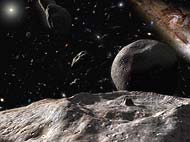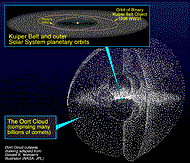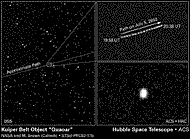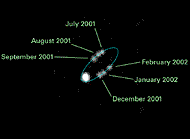
|
Table of Contents |
|
The Kuiper Belt
|

|
| Kuiper Belt/Oort Cloud Relationship. [more] |
This notion was reinforced by the realization that there is a separate population of comets, called the Jupiter family, that behave strikingly different than those coming from the far reaches of the Oort cloud. Besides orbiting the Sun in less than 20 years (as opposed to 200 million years for an Oort member), the comets are unique because their orbits lie near the plane of the Earth's orbit around the Sun. In addition, all these comets go around the Sun in the same direction as the planets.
Kuiper's hypothesis was reinforced in the early 1980s when computer simulations of the solar system's formation predicted that a disk of debris should naturally form around the edge of the solar system. According to this scenario, planets would have agglomerated quickly in the inner region of the Sun's primordial circumstellar disk, and gravitationally swept up residual debris. However, beyond Neptune, the last of the gas giants, there should be a debris-field of icy objects that never coalesced to form planets.
The Kuiper belt remained theory until the 1992 detection of a 150-mile wide body, called 1992QB1 at the distance of the suspected belt. Several similar-sized objects were discovered quickly confirming the Kuiper belt was real. The planet Pluto, discovered in 1930, is considered the largest member of this Kuiper belt region. Also, Neptune's satellites, Triton and Nereid, and Saturn's satellite, Phoebe are in unusual orbits and may be captured Kuiper belt objects.
 Object 1993 SC
Object 1993 SC
This image shows a small part of the discovery frames of 1993 SC,
one of the brightest Kuiper-Belt objects so far discovered. It was
taken using the 2.5 meter Isaac Newton Telescope on La Palma by Alan
Fitzsimmons, Iwan Williams and Donal O'Ceallaigh on September 17, 1994.
The two images are separated in time by 4.6 hours, and by comparing
them it is clear that one of the objects has moved from upper left of
center to a point where its image almost merges with that of a distant
galaxy. This motion marks it as being a distant member of our solar
system, further away than the planet Neptune.
Subsequent observations over the past year confirm that it is currently
34.0 AU from the sun; however, with a moderate orbital eccentricity of
0.18 it might travel as far as 48 AU. Assuming that Object 1993 SC
reflects light much like other primitive asteroids and comets in the
out solar system, the diameter is around 300 kilometers (186 miles),
or just a quarter the size of Pluto's moon Charon.
(Courtesy Alan Fitzsimmons, Iwan Williams and Donal O'Ceallaigh)
 Quaoar, an Icy World Far Beyond Pluto
Quaoar, an Icy World Far Beyond Pluto
With the help of NASA's Hubble Space Telescope, astronomers have
determined that 2002 LM60, an icy Kuiper belt object dubbed "Quaoar,"
by its discoverers, is the largest body found in the solar system
since the discovery of Pluto 72 years ago. Quaoar (pronounced kwa-whar)
is about half the size of Pluto. Like Pluto, Quaoar dwells in the
Kuiper belt.
The photograph at bottom right is a close-up view of the icy world. Only Hubble's
sharp vision can resolve the disk of this distant world, leading
to the first-ever direct measurement of the true size of a Kuiper
belt object. Quaoar's diameter is about 800 miles (1300
kilometers). It is the farthest object in the solar system ever
to be resolved by a telescope. Quaoar is about 4 billion miles
(6.5 billion kilometers)
from Earth, more than 1 billion miles farther than Pluto.
 Binary KBO's at the Fringe of Our Solar System
Binary KBO's at the Fringe of Our Solar System
NASA's Hubble Space Telescope snapped pictures of a double system of icy
bodies in the Kuiper Belt. This composite picture shows the apparent
orbit of one member of the pair. In reality, the objects, called 1998
WW31, revolve around a common center of gravity, like a pair of waltzing
skaters. This picture shows the motion of one member of the duo [the six
faint blobs] relative to the other [the large white blob]. The blue oval
represents the orbital path. Astronomers assembled this picture from six
separate exposures, taken from July to September 2001, December 2001,
and January to February 2002.
 The Orbit of 1998 WW31 in the Kuiper Belt
The Orbit of 1998 WW31 in the Kuiper Belt
This illustration compares the orbit of the binary Kuiper Belt object,
called 1998 WW31, with the orbits of Pluto and Neptune, the outermost
solar system planets. The inset picture, consisting of six snapshots
taken by NASA's Hubble Space Telescope, shows one member of the Kuiper
Belt pair [the faint white blobs] during its elliptical orbit. The
bright white object at the bottom of the oval is the other member
of the pair.
 Hubble Detection of Comet Nucleus
Hubble Detection of Comet Nucleus
This pair of images shows one of the candidate Kuiper Belt objects
found with Hubble Space Telescope. The object is believed to be an
icy comet nucleus several miles across. Each photo is a 5-hour
exposure of a piece of sky carefully selected such that it is nearly
devoid of background stars and galaxies that could mask the elusive
comet.
The left image, taken on August 22, 1994, shows the candidate comet
object (inside circle) embedded in the background. The right picture,
taken of the same region one hour forty-five minutes later, shows the
object has apparently moved in the predicted direction and rate of
motion for a Kuiper Belt member. The dotted line on the images is a
possible orbit that this Kuiper Belt comet is following. A star (lower
right corner) and a galaxy (upper right corner) provide a static
background reference. In addition, other objects in the picture have
not moved during this time, indicating they are outside our solar
system.
(Credit: A. Cochran, University of Texas/NASA)

 Comet
Comet Shoemaker-Levy 9 Impact
Shoemaker-Levy 9 Impact